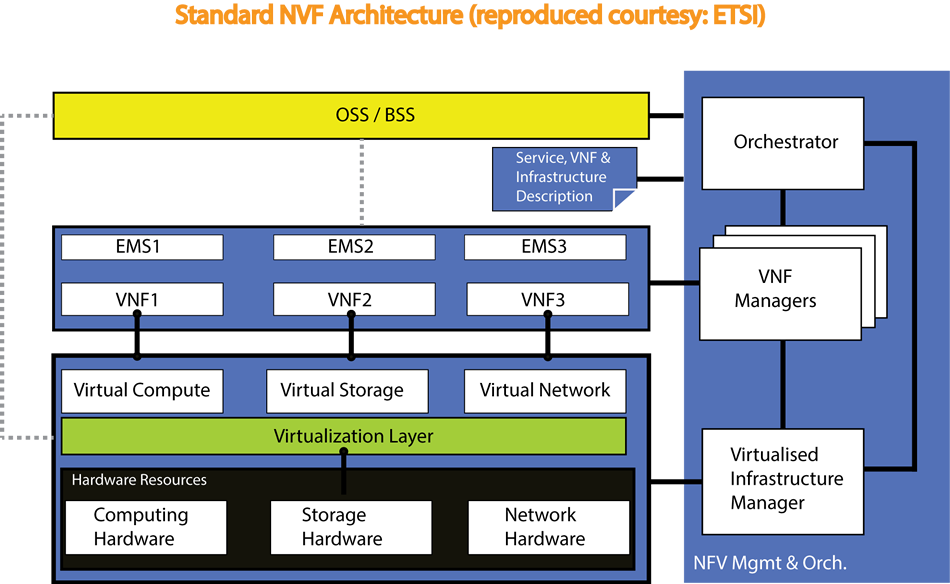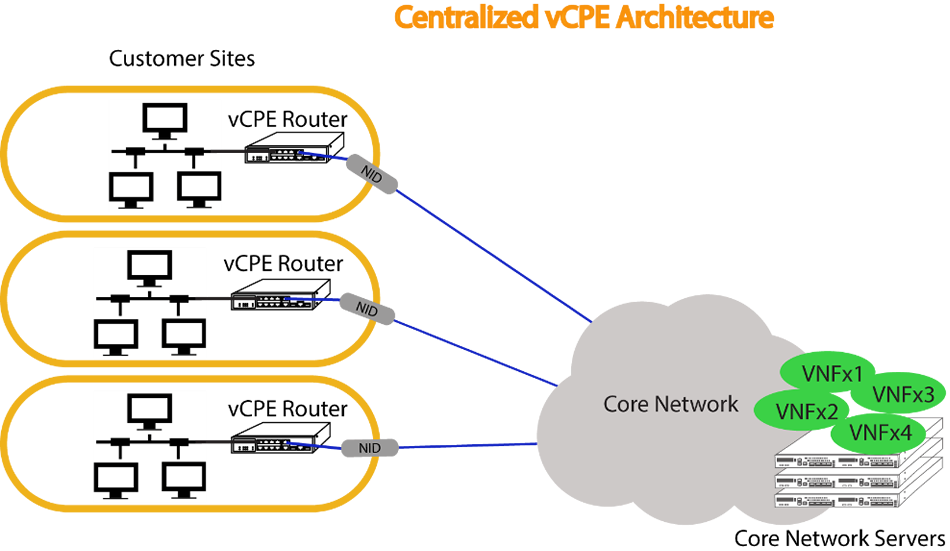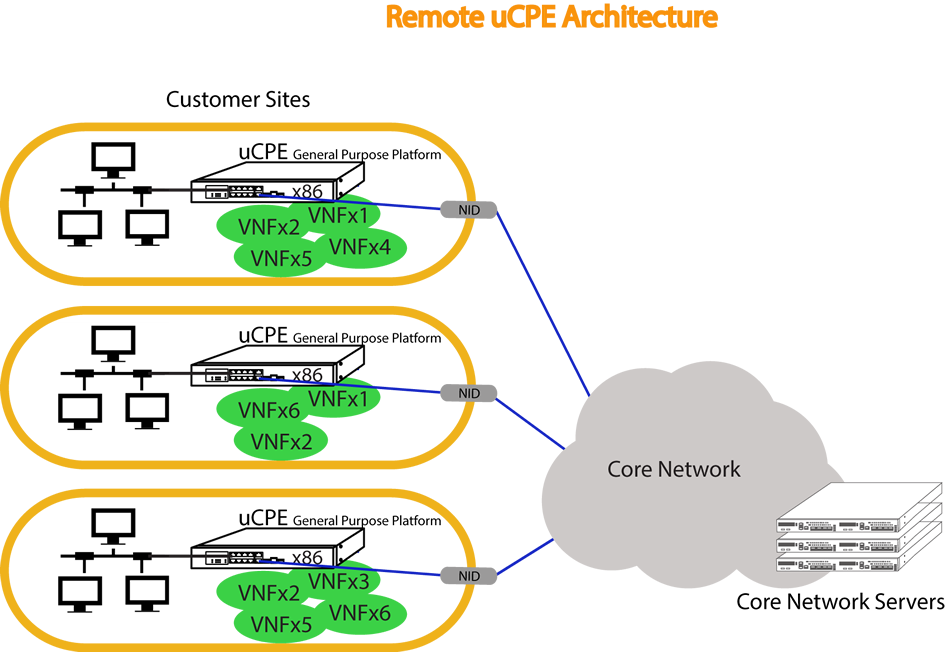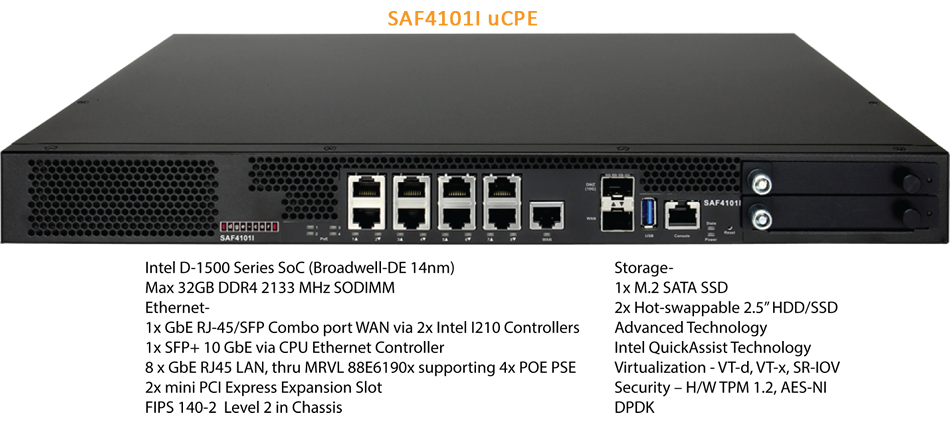Virtualization of CPEs
Towards the Software-Defined CPE
Customer Premise Equipment (CPE) has traditionally required costly professional onsite configuration of devices with specialized but inflexible onboard functional ASICs. Although this type of CPE provides the customer with a potent and cost-effective solution, changing or adding services has, in normal cases, required new equipment installation or modification, which reduces profits and customer satisfaction. As communication providers implement and expand software-defined communication technologies, the virtualization of services for customers can now replace technician site visits with touch-free configuration of embedded x86 devices. Virtualization of CPE services means a provider can rapidly add new virtualized functions, resulting in cost savings for both the customer and themselves.
To realize this type of virtualization at service delivery sites, CPEs have evolved into flexible “off-the-shelf” network appliances that can function as part of software-defined technologies such as SD-WAN communication architecture. This means that network functions traditionally handled by CPE hardware have transformed into Virtualized Network Functions (VNFs) through the architecture specified by ETSI known as Network Functions Virtualization (NFV). This architecture, as illustrated below, pairs VNFs with Element Management Systems (EMS) and controls them through VNF managers remotely as part of a management and orchestration block.

Virtualizing CPE hardware functions into VNFs means that the customer premise equipment can use common x86-type or other general processor-based platforms at the hardware resource layer instead of expensive and inflexible ASIC orientated gear.
Implementing Virtualized Network Functions
There are a multitude of on-premise functions that can be virtualized. A VNF implements specific network functions as virtual services within the NFV architecture. Already, basic network technologies such as switching, routing, and firewall are supported in almost any virtualized CPE. Routing, for example, is usually included with a standard OS package such as Linux. The list, however, is easily expanded to almost any other network technology, such as for example, spam filtering, malware detection, and advanced functions such as session controllers. With a standard x86 and Linux canvas to design for, NFV vendors can recreate traditional and future customer services into pre-packaged VNFs ready for immediate deployment.
Firewall services, for instance, can be deployed conveniently as a VNF to protect sensitive business data. And similar to a firewall VNF, a Session Border Controller (SBC) deployed in VNF form provides protection for enterprise PBX VoIP calls. An SBC VNF can hide the underlying VoIP topology, manipulate the call protocol to match the WAN side requirements (for example, number presentation), and encrypt and transcode an outgoing call whenever necessary. Further, this type of VNF can examine incoming calls and classify them. Classification can identify and block malicious callers from a known database. An SBC VNF is simply one of a multitude of services deployable virtually without onsite configuration. VNFs give providers and customers the capability to evolve or swap out services completely at any time with minimal OPEX and CAPEX costs.
The Power of the Universal CPE
As virtualized services and architectures have evolved, two types of CPEs have arisen; the vCPE and the uCPE. Each case is loosely defined; therefore, the descriptions in this brief are not absolute.
A vCPE, or virtualized CPE, roughly equates to an appliance that has only a little more to do than local MAC-layer switching. The VNFs reside in other nodes that are part of the network cloud. Which layer and where the node resides is indeterminate, that is the VNF and its associated orchestration can be anywhere from the network core to servers at the same customer site. Due to off-boarding of the network functions, a vCPE device is simple, yet it relies on having a speedy and reliable data pipe to the cloud-based functions to carry out VNF functions such as local routing, firewall, or security functionality.

In the other case, a uCPE (universal CPE) is a far more powerful device that still incorporates some physical capabilities that a traditional CPE would employ. However, it unloads other duties into virtualized functions that execute on its own general-purpose processing platform. Additionally, even orchestration can take place onboard the uCPE itself. Having a self-contained device with localized orchestration and VNFs results in a device that is not constrained by slow connectivity to the cloud. This improves customer-end performance compared with vCPEs and still provides the time-to-market advantage to update services instantly and touch-free. Moreover, this balance means that uCPE devices are now at the forefront in virtualized premise equipment, deploying in greater numbers than ever before.

Defining uCPE Characteristics
What are the components that make a uCPE? This is by no means set in stone, more of a general scope. Firstly, at its most basic, a uCPE needs to be a server that can host the virtual functions. This could be either a bare-metal unit or a whitebox. On top of that, the uCPE can run either an open software kit (requiring in-house developers) or standard manufacturer software. The uCPE software must be built using standard components as the architectural framework. Accordingly, the OS is typically Linux utilizing components such as OpenStack with KVM hypervisor and containerization technology for the NFV components. The platform must have the capability to exchange software components easily and efficiently, particularly to automate updates and additions for customers. Updates and new services must be deployable in a touch-free manner avoiding any on-site visits. Finally, the uCPE must work with both existing and future networks with their network side connectivity supporting anything from ancient TDM/DSL systems to FTTx or Gigabit cable solutions. With these transport media, uCPEs must integrate with any type of host solutions and be able to do this at any scale.
SD-WANs Need Flexible uCPEs
When deploying enterprise-grade uCPEs, integration with SD-WAN becomes crucial as bandwidth consumption increases. SD-WAN provides a networking structure layered over the Internet so that enterprises are free to choose inexpensive bandwidth versus costly MPLS services. However, in the case of certain service-level agreements where companies require guaranteed service, MPLS may still be required. In these cases, uCPEs can still deal with both the SD-WAN overlay network and MPLS by simply deploying the applicable VNFs to deal with each service. This flexibility in the enterprise arena makes uCPE devices very favorable indeed.
An Example uCPE Solution
In line with SD-WAN and other enterprise-level uCPE applications, Accton Technology Corporation offers a line of flexible uCPE appliances, such as our Edgecore-branded SAF series. These uCPE appliances can function as a middle to high-level network computing hardware platform. They are based on Intel Broadwell-DE or Denverton-NS technology which can provide anywhere from 2 to 16 cores in their CPU families. Equipped with multiport Ethernet controllers and Intel CPUs, the SAF series are an ideal example of off-the-shelf uCPEs with high-performance general computing power and high-bandwidth network throughput that can support demanding VNF services.

By utilizing standard Intel® x86-communication hardware, the SAF series uCPE appliances provide openness and flexibility to fulfill various use cases such as VNFs in an SD-WAN environment. These platforms support both open-source-based software and third-party VNFs to match premise application requirements, so that a provider can deliver or update virtual services promptly and cost-effectively.
uCPE Platforms Enable Network Evolution
uCPE and vCPE devices for telecom and network operators provide flexible virtualized services. Especially, uCPE devices can do this by utilizing general-purpose hardware at customer sites with self-sufficient onboard NFV architecture that translates to both a gain in earnings and customer satisfaction. Further, network evolution can be deployed expediently without involving equipment swaps and the labor costs therein. SD-WAN services integrated with uCPEs reduce enterprise MPLS costs where a premium service is non-essential. Current uCPE platforms can provide a range of specifications to support VNFs available now and in the future.





